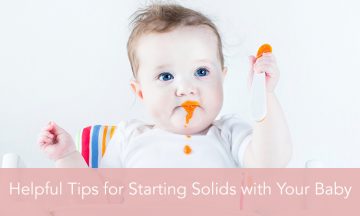Helpful Tips for Starting Solids with Your Baby
Author: Shannon Miller Lifestyle

Starting solid foods with your baby is a BIG step!
It is the very beginning of the weaning process and something that many parents stress over. However, it can be a very enjoyable time of exploring new things with your baby. Today, we will cover the timeline of when to start solids, why it is important to take things slow, common allergens and what to do if an allergen arises, some great first foods, and what are some different ways of preparing foods for baby.
When to start?
The first big question most parents have is when should you start solid foods with your baby. Well, there are a few things you should look in your baby that indicate that baby is ready for solid foods.
The first is that Baby is at least 6 months old, and if Baby was premature going by their adjusted age is appropriate. The AAP recommends this for numerous reasons, including but not limited to: increased immune system health, proper development of baby’s digestive system, lower risk of obesity in the future, protection from iron-deficiency anemia, and mom will more easily maintain her milk supply.
The second is that baby has outgrown the “tongue thrusting” reflex. This is a reflex that babies are born with to aid in the prevention of choking on unusual objects placed in their mouth. This is typically outgrown around the time baby is 6 months old, but don’t worry if it takes a little longer with your baby, it is completely normal.
The third is that they can sit up in a high chair, and preferably that they can sit up unassisted in general. This is important for a few reasons. The first is choking; if baby cannot properly sit up they are more at risk to choke on small pieces of food. The second is the differentiation of eating solid foods between breast or bottle feeding; feeding an infant is a very intimate thing, they are accustomed to being held in warm arms and close to their caregiver, and the introduction of solids is a much less intimate and more mechanical way of delivering nutrients.
Take it slow…
“Food under one is just for fun.” This phrase has become a popular one in recent years, and it seems to take much of the stress out of the journey of beginning solids with your baby. The introduction of solids shouldn’t be rushed; babies will learn to eat over a period of time. Eating full meals is not something that happens overnight. Breast milk or formula will still remain the main nutritional source for a baby until after they are a year old, but up until then, eating is about discovery.
Giving solids after a feeding at the breast or bottle is recommended. It is good to wait about 30 minutes after a feeding to give solids, so baby isn’t extremely hungry or too full. It is also good to avoid introducing solids when baby is sick or overly tired or cranky.
When introducing new foods, things should be taken slowly as well. The general rule is to give one new type of food for 3 to 5 days before introducing another new food. This is so you are able to watch your baby for signs of a possible sensitivity or allergy.
Food sensitivities and allergies to foods are a major concern with starting solids. Some foods, like nuts, peanuts in particular are typically a major thing to avoid until after a year old due to the high prominence of peanut and other nut allergies. Some other common allergens include milk, eggs, wheat, soy, fish, and shellfish. There is recent research by the AAP that has noted that unless there is a family history of these allergens, there is no reason to avoid them altogether, but it may be best to wait until baby is slightly older before introducing them.
Food allergy symptoms usually appear very soon after the food is eaten — within a few minutes to a couple of hours. If you’re introducing a new food to your baby, keep an eye out for these symptoms:
- Hives or welts
- Flushed skin or rash
- Face, tongue, or lip swelling
- Vomiting and/or diarrhea
- Coughing or wheezing
- Difficulty breathing
- Loss of consciousness
Severe allergic reactions can be fatal very quickly. If your baby is having trouble breathing/wheezing, has swelling on her face/lips, or develops severe vomiting or diarrhea after eating, immediately call 911. You can inform your pediatrician at a later time.
If you see mild symptoms, such as hives or a rash, contact your pediatrician for further evaluation. Once your baby’s specific allergies are identified, the doctor will give you an action plan for managing the allergies (usually, eliminating the food from your baby’s diet) and dealing with accidental exposures.Remember, just because a baby’s initial allergic reaction to a new food may be mild, it may get worse upon following exposures. Talk to your pediatrician about any food allergy symptoms in your baby. Some allergies go away with time. Egg and milk allergies often go away as children get older, but peanut, tree nut, and shellfish allergies tend to persist.
What are some great first foods for baby to try?
Rice cereal has been a common first food for the past few decades. It is easy to digest and is fortified with iron. However many studies are now showing that rice cereal may have a high amount of arsenic in it and many professionals are now recommending to skip the rice cereal altogether, so if you are opting to go with a grain cereal, oatmeal may be a better option. However, starting with grains is not necessary at all. Vegetables and fruits, then meat and grains, are a great way to start.
Creating little meals for your little one can be so much fun! Although jarred baby foods are great for saving time, some babies won’t eat them since they really don’t have much flavor to them, and don’t fret if your baby doesn’t like them! Pureeing your own foods or the baby-led weaning approach to feeding is great as well. And you can try any combination of those methods, you don’t have to just pick one! Variety will help your baby to not be a picky eater! If you are pureeing yourself or using baby led weaning, it’s generally a good rule of thumb that if a food is already soft there is no need to cook it, but with the harder foods, it’s a great idea to steam it first to make it soft. Also, if you are making your own foods for baby, don’t be afraid to add seasonings after baby has tried something a few times; adding garlic, rosemary, pepper, cinnamon, etc., after an initial introduction of the food adds more variety!
Some great first foods to try:
- Avocado
- Apple
- Banana
- Carrots
- Sweet potato
- Butternut squash
- Melon
- Peaches
- Plums
- Pears
- Peas
- Green beans
- Asparagus
- Zucchini
- Yellow Squash
- Parsnips
- Cauliflower
- Cucumber
- Broccoli
- Cooked Beets
- Pumpkin
- Eggplant
- Bell peppers
Once Baby has a good grasp on several of those, you can also add a little more variety with some of these foods:
- Meats like beef, chicken, or turkey
- Scrambled eggs
- Cheese (small chunks or shredded)
- Yogurt
- Tofu
- Brown rice
- Cooked pasta
- Steel Cut oatmeal
- Cooked Fish
The possibilities are endless, so be creative! Just remember that if your baby doesn’t seem to like something, wait a few weeks and try it again! What has worked well for you or what advice would you share with other parents on introducing solids? Share with us in a comment below!
References: AAP, Kelly Mom, Dr. Sears, Baby Led Weaning, MD Mama Dr. Claire McCarthy
